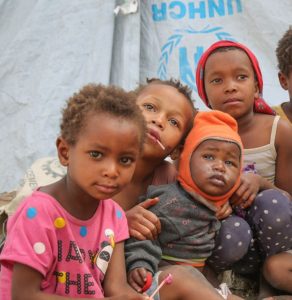Yemen now the world’s worst humanitarian crisis
Seven years after the war in Yemen began, it is set to be declared by the UN as the world’s worst humanitarian crisis.
A UN team is currently assessing the dire situation in the war-ravaged nation with a view to assessing its needs as widespread famine looms.
Almost six million people have been uprooted from their homes and more than 23.4 million are in dire need of humanitarian assistance, the UNHCR says.
The risk of a large-scale famine is imminent with tens of thousands of people are already living in famine-like conditions, and another five million on the brink.
Food shortages have been exacerbated by the war in Ukraine, which is a major supplier of grain to Africa and the Middle East.
Yemen’s civil war began in 2015 as a result of clashes between Yemeni government forces and ethnic Houthis.
Over the past seven years, conflict and economic decline have taken a heavy toll on civilians, forcing millions to flee their homes and leaving 73 percent of the population in dire need of humanitarian assistance.
 Even before the current crisis, Yemen was the most vulnerable country in the Middle East. It ranked among the world’s worst in malnutrition rates and half of its population was living in poverty, without access to safe water.
Even before the current crisis, Yemen was the most vulnerable country in the Middle East. It ranked among the world’s worst in malnutrition rates and half of its population was living in poverty, without access to safe water.
Nearly six million Yemenis have been displaced from their homes since the beginning of the crisis, including 4.3 million internally displaced people inside Yemen.
By the end of 2021, Yemen had the fifth largest number of internally displaced people (IDPs) in the world – after Syria, Colombia, the DRC, and Afghanistan.
Many of the IDPs have been living in exile for years, straining their meagre resources and facing increasingly harsh conditions, according to UNHCR reports.
Incredibly, despite the conflict, Yemen hosts more than 97,000 refugees and asylum seekers, mostly from Somalia and Ethiopia.
UNHCR says the risk of a large-scale famine, violence, collapsing services and lasting displacement are the biggest challenges in Yemen.
Seven years of conflict has pushed the country to the brink of economic collapse, severely compounding needs that were already high due to years of poverty and insecurity.
The number of food insecure people is projected to rise to 19 million by December 2022.
And the COVID-19 pandemic has made things worse – with people’s immune systems already severely weakened after years of war and deprivation, Yemenis continue to grapple with the effects of the virus and outbreaks of other preventable diseases – such as cholera, diphtheria, measles, and dengue fever – that were long-ago eradicated elsewhere in the world.
Women and children are bearing the brunt of the crisis. They constitute 79 per cent of the internally displaced population and are finding themselves in increasingly difficult circumstances.
As of March 2021, one in four displaced Yemeni families was headed by a woman or girl — 20 per cent of whom were under the age of 18.
Women and girls are forced to take on the responsibility to sustain their families while facing inequality, limited access to services and multiple barriers due to entrenched sociocultural norms.
With rampant inflation and few livelihood opportunities, many can no longer afford basic meals and are facing heightened risks of starvation, gender-based violence, exploitation and early marriage.
Malnutrition rates among women and children in Yemen remain among the highest in the world, with 1.3 million pregnant or breastfeeding women requiring treatment for acute malnutrition.
Meanwhile, Yemeni children continue to be killed and injured because of the conflict and are dying at increasingly high rates due to preventable diseases and malnutrition. Today, 2.2 million children under the age of 5 in Yemen require treatment for acute malnutrition.












